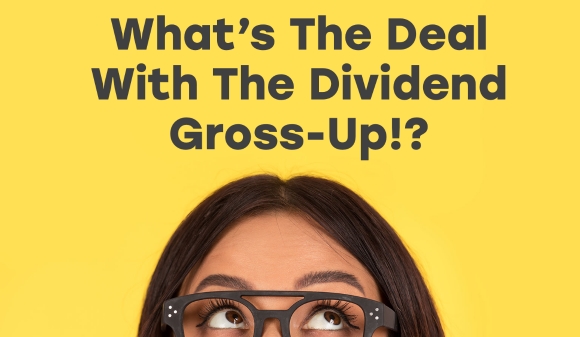What’s The Deal With The Dividend Gross-Up!?

 I absolutely love dividend income. One of my rules for investing in stocks is it must pay a dividend. If the stock does not pay a dividend, I am much less likely to want to buy that stock. There are, of course, some exceptions to my dividend love affair rule. But the idea of sitting back, relaxing, and doing, quite literally, absolutely nothing, and have money rolling in, definitely appeals to me. Perhaps that makes me sound lazy, but as Warren Buffet said, and I paraphrase, “If you don’t find a way to make money in your sleep, you’ll be working until you’re dead!”
I absolutely love dividend income. One of my rules for investing in stocks is it must pay a dividend. If the stock does not pay a dividend, I am much less likely to want to buy that stock. There are, of course, some exceptions to my dividend love affair rule. But the idea of sitting back, relaxing, and doing, quite literally, absolutely nothing, and have money rolling in, definitely appeals to me. Perhaps that makes me sound lazy, but as Warren Buffet said, and I paraphrase, “If you don’t find a way to make money in your sleep, you’ll be working until you’re dead!”
The taxation of dividends in Canada can be a tad confusing and leads to a few common questions. For example, is there double tax considering the corporation pays tax on its income, pays a dividend to the shareholder, and then the shareholder pays tax on that dividend? Is it worth it to receive dividend income considering it will be “grossed-up” and inflate my taxable income? Is it true one can earn $50,000 of dividend income and not pay any tax assuming one has no other income?
Let’s examine these questions one by one.
Double Tax
Assume you earn an eligible dividend from a company called Taxes Cause Grumpiness Ltd or TCGL for short. TCGL pays corporate income taxes on its taxable income. Any after-tax profits that TCGL accumulates are known as “retained earnings”. Retained earnings: earnings or income that are being retained, or kept, in the company. When TCGL pays a dividend to its shareholders, the dividends are being paid from the retained earnings. Meaning, income tax has already been paid on the income from whence the dividend is coming from. Therefore, dividends are paid from TCGL from after-tax funds. Now, when the shareholder receives the dividend, the dividend is reported on a T-5 slip and the shareholder must include the amounts reported on the T-5 slip in their income during that taxation year.
The dividend is then “grossed-up”. For example, assume you earn $5,000 of eligible dividend income, this will be grossed-up by 38%1 to $6,900. So, $6,900 must be included in income, and taxes will be paid at the taxpayer’s marginal rate, depending on all other sources of income the taxpayer has. However, to account for the fact that this dividend comes from income that has already been taxed at the corporate level, there is something very beautiful and magical our politicians have granted us. This is known as the “dividend tax credit.” The dividend tax credit is calculated as 15% of the amount that was grossed-up. In our case, this is $1,036. ($6,900 x 15%2 = $1,036). This dividend tax credit is meant to offset some of the corporate income tax that was paid on the corporate level. It doesn’t perfectly offset all the corporate income tax that was paid but it helps alleviate some of the problem of double taxation.
Gross-up Issues
What’s the deal with the gross-up? The reason why the dividend you received is grossed-up is to bring the amount of the dividend that you received back to an amount that the corporation had to earn pre-tax in order to pay that dividend. So, if the corporation is paying a dividend of $5,000, it had to earn $6,900, pay some corporate tax and then pay the dividend. The dividend tax credit, in theory, represents the corporate income tax that was paid, which you now get credit for. Of course, depending on what income tax bracket you are in, based on all your other sources of income, this never works out perfectly in reality.
One important thing to watch out for is people who are approaching or are in retirement. Anyone receiving Old Age Security (OAS) will begin to have their OAS clawed back once they reach $79,054 of net income and will have it clawed back entirely, once they reach $128,1493 of net income. Unfortunately, the grossed-up amount of the dividend is included in your net income, artificially raising your income for the OAS clawback threshold.
Another issue is Registered Retirement Savings Plan (RRSP) withdrawals. In the year after you turn 71, amounts from your RRSP, once converted to a Registered Retirement Income Fund (RRIF), begin to be included in your income each year at fixed amounts. This may push you into a higher tax bracket. You must be mindful that the grossed-up amounts of dividend income received, along with the RRIF withdrawals, can keep pushing you into higher tax brackets. That’s not to say dividend income isn’t worth it. Of course it is, but you must be aware of the OAS clawback and take into account all sources of income, including Canada Pension Plan (CPP) income when undergoing retirement planning.
Tax-free Living
One strategy we don’t hear of is based on the idea that you can earn approximately $50,000 of eligible dividend income and pay zero tax4, assuming you have no other sources of income. How is this possible!?
If someone earns $50,000 of salary income from working hard at their job, they will pay approximately $8,120 of income tax5. But $50,000 of dividend income, assuming no other income, and they pay zero tax!?
This is possible because of the magical dividend tax credit as explained above. Even $60,000 of dividend income only generates a tax bill of $2,139, which is an effective tax rate of 3.5%! And $70,000 of dividend income generates a tax bill of $4,167, or six per cent.
So how do you achieve this incredible tax-minimization strategy? Simply keep investing in a portfolio of publicly-traded Canadian companies that pay nice amounts of dividends. Whether you re-invest the dividends, you have to include the dividends in your income, so may as well keep re-investing and watching the effects of compounding work their magic. Imagine a portfolio worth $1.2 million paying four per cent dividends. The dividend income would be $48,000. If you have zero other income, welcome to tax-free living.
Even if you are receiving the maximum CPP and OAS along with the $50,000 of dividend income, your total tax bill would only be $5,5276 which represents a favourable effective tax rate of 7.7%.
The bottom line is dividend-paying stocks should be part of your investment plan. Holding dividend-paying stocks in a non-registered account is typically beneficial because of the dividend tax credit. Of course, beware the capital gains tax upon selling such dividend stocks or on the date of death when your assets are deemed to have been sold.
Neal Winokur is the author of The Grumpy Accountant—One Fed Up Tax Pro’s Practical Plan to Fix Canada’s Senselessly Complicated Tax System! He can be reached through his website at www.grumpyaccountant.ca. The Grumpy Accountant is now available at Amazon.ca.
1 2020 rate.
2 2020 rate.
3 2020 figures.
4 Aside from the $376 Ontario Health Premium, which many provinces do not have. Based on 2020 combined federal and Ontario tax rates.
5 Based on 2020 combined federal and Ontario tax rates.
6 Based on 2020 combined federal and Ontario tax rates.


